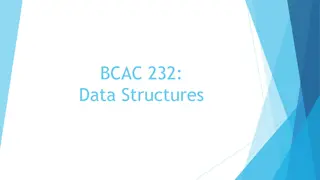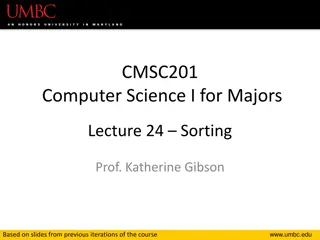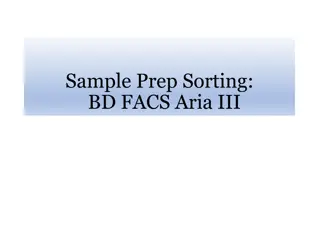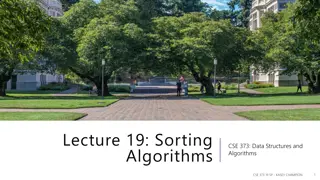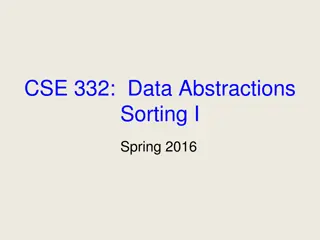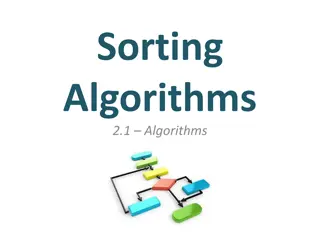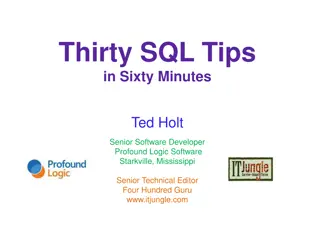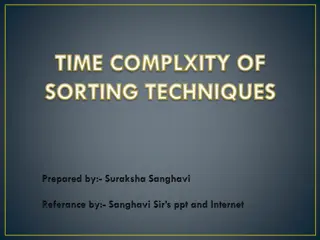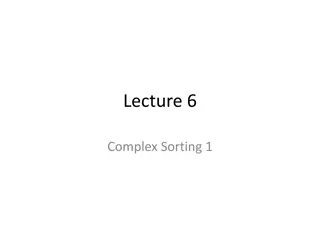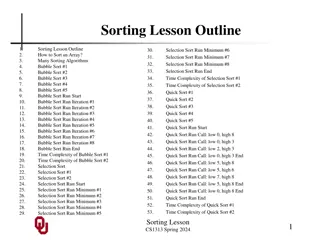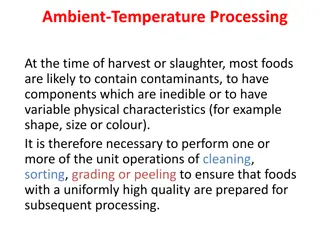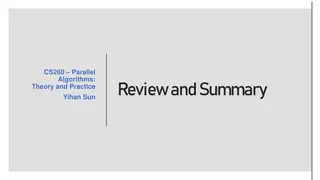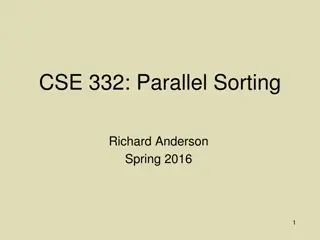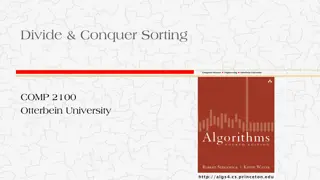Introduction to Algorithms and Sorting Techniques
Brute force and exhaustive search are fundamental problem-solving approaches in algorithm design, while selection sort and bubble sort are common sorting techniques. Brute force involves solving problems directly based on the problem statement, with the computer carrying out the computations. Selection sort, on the other hand, involves scanning a list to find the smallest element iteratively, placing it in its proper position. These techniques are essential in understanding algorithm design and analysis, serving as building blocks for more complex algorithms.
Download Presentation

Please find below an Image/Link to download the presentation.
The content on the website is provided AS IS for your information and personal use only. It may not be sold, licensed, or shared on other websites without obtaining consent from the author. Download presentation by click this link. If you encounter any issues during the download, it is possible that the publisher has removed the file from their server.
E N D
Presentation Transcript
Brute Force and Exhaustive Search 0750323 ALGORITHMS DR. RANEEM QADDOURA 0750323 Algorithms Philadelphia University Dr. Raneem Qaddoura Introduction to Design and Analysis of Algorithms Anany Levitin
Brute Force and Exhaustive Search Brute force is a straightforward approach to solving a problem, usually directly based on the problem statement and definitions of the concepts involved. The force implied by the strategy s definition is that of a computer and not that of one s intellect. Just do it! would be another way to describe the prescription of the brute-force approach. And often, the brute-force strategy is indeed the one that is easiest to apply. As an example, consider the exponentiation problem: compute an ??for a nonzero number ? and a nonnegative integer ?. Although this problem might seem trivial, it provides a useful vehicle for illustrating several algorithm design strategies, including the brute force. By the definition of exponentiation, ??= ? ? (? ?????) This suggests simply computing ??by multiplying 1 by ? ? times 0750323 Algorithms Philadelphia University Dr. Raneem Qaddoura Introduction to Design and Analysis of Algorithms Anany Levitin
Selection Sort and Bubble Sort 0750323 Algorithms Philadelphia University Dr. Raneem Qaddoura Introduction to Design and Analysis of Algorithms Anany Levitin
Selection Sort Problem of sorting: given a list of ? orderable items (e.g., numbers, characters from some alphabet, character strings), rearrange them in nondecreasing order. Selection sort: scanning the entire given list to find its smallest element and exchange it with the first element, putting the smallest element in its final position in the sorted list. Then we scan the list, starting with the second element, to find the smallest among the last ? 1 elements and exchange it with the second element, putting the second smallest element in its final position. Generally, on the ?th pass through the list, which we number from 0 to ? 2, the algorithm searches for the smallest item among the last ? ? elements and swaps it with ??: After n 1 passes, the list is sorted. 0750323 Algorithms Philadelphia University Dr. Raneem Qaddoura Introduction to Design and Analysis of Algorithms Anany Levitin
Selection Sort The analysis of selection sort is straight forward. The input size is given by the number of elements n The basic operation is the key comparison A[j ] < A[min]. The number of times it is executed depends only on the array size Thus, selection sort is a (?2) algorithm on all inputs. The number of key comparisons for the selection sort version given above is the same for all arrays of size ? the number of key swaps is only (?), or, more precisely, ? 1 (one for each repetition of the ? loop). This property distinguishes selection sort positively from many other sorting algorithms 0750323 Algorithms Philadelphia University Dr. Raneem Qaddoura Introduction to Design and Analysis of Algorithms Anany Levitin
Selection Sort Example of sorting with selection sort. Each line corresponds to one iteration of the algorithm, i.e., a pass through the list s tail to the right of the vertical bar; an element in bold indicates the smallest element found. Elements to the left of the vertical bar are in their final positions and are not considered in this and subsequent iterations. 0750323 Algorithms Philadelphia University Dr. Raneem Qaddoura Introduction to Design and Analysis of Algorithms Anany Levitin
Bubble Sort Problem of sorting: given a list of ? orderable items (e.g., numbers, characters from some alphabet, character strings), rearrange them in nondecreasing order. Bubble sort: Another brute-force application to the sorting problem is to compare adjacent elements of the list and exchange them if they are out of order. By doing it repeatedly, we end up bubbling up the largest element to the last position on the list. The next pass bubbles up the second largest element, and so on, until after ? 1 passes the list is sorted. Pass i (0 i ? 2) of bubble sort can be represented by the following diagram: 0750323 Algorithms Philadelphia University Dr. Raneem Qaddoura Introduction to Design and Analysis of Algorithms Anany Levitin
Bubble Sort The number of key comparisons for the bubble- sort version given above is the same for all arrays of size ?; it is obtained by a sum that is almost identical to the sum for selection sort The number of key swaps, however, depends on the input. In the worst case of decreasing arrays, it is the same as the number of key comparisons: 0750323 Algorithms Philadelphia University Dr. Raneem Qaddoura Introduction to Design and Analysis of Algorithms Anany Levitin
Bubble Sort First two passes of bubble sort on the list 89, 45, 68, 90, 29, 34, 17. A new line is shown after a swap of two elements is done. The elements to the right of the vertical bar are in their final positions and are not considered in subsequent iterations of the algorithm. 0750323 Algorithms Philadelphia University Dr. Raneem Qaddoura Introduction to Design and Analysis of Algorithms Anany Levitin
Sequential Search The algorithm simply compares successive elements of a given list with a given search key until either a match is encountered (successful search) or the list is exhausted without finding a match (unsuccessful search). A simple extra trick is often employed in implementing sequential search: if we append the search key to the end of the list, the search for the key will have to be successful, and therefore we can eliminate the end of list check altogether. Another straightforward improvement can be incorporated in sequential search if a given list is known to be sorted: searching in such a list can be stopped as soon as an element greater than or equal to the search key is encountered. 0750323 Algorithms Philadelphia University Dr. Raneem Qaddoura Introduction to Design and Analysis of Algorithms Anany Levitin
String Matching Problem : given a string of n characters called the text and a string of m characters (m n) called the pattern, find a substring of the text that matches the pattern. Brute-force Solution: align the pattern against the first m characters of the text and start matching the corresponding pairs of characters from left to right until either all the m pairs of the characters match (then the algorithm can stop) or a mismatching pair is encountered. In the latter case, shift the pattern one position to the right and resume the character comparisons, starting again with the first character of the pattern and its counterpart in the text. Note that the last position in the text that can still be a beginning of a matching substring is n m (provided the text positions are indexed from 0 to n 1). Beyond that position, there are not enough characters to match the entire pattern; hence, the algorithm need not make any comparisons there. 0750323 Algorithms Philadelphia University Dr. Raneem Qaddoura Introduction to Design and Analysis of Algorithms Anany Levitin
Depth-First Search (DFS) Depth-first search starts a graph s traversal at an arbitrary vertex by marking it as visited. On each iteration, the algorithm proceeds to an unvisited vertex that is adjacent to the one it is currently in. (If there are several such vertices, a tie can be resolved by the alphabetical order of the vertices.) This process continues until a dead end a vertex with no adjacent unvisited vertices is encountered. At a dead end, the algorithm backs up one edge to the vertex it came from and tries to continue visiting unvisited vertices from there. The algorithm eventually halts after backing up to the starting vertex, with the latter being a dead end. By then, all the vertices in the same connected component as the starting vertex have been visited. If unvisited vertices still remain, the depth-first search must be restarted at any one of them. 0750323 Algorithms Philadelphia University Dr. Raneem Qaddoura Introduction to Design and Analysis of Algorithms Anany Levitin
Depth-First Search (DFS) It is convenient to use a stack to trace the operation of depth-first search. We push a vertex onto the stack when the vertex is reached for the first time, and we pop a vertex off the stack when it becomes a dead end. It is also very useful to accompany a depth-first search traversal by constructing the so-called depth-first search forest. The starting vertex of the traversal serves as the root of the first tree in such a forest. Whenever a new unvisited vertex is reached for the first time, it is attached as a child to the vertex from which it is being reached. Such an edge is called a tree edge because the set of all such edges forms a forest. a, c, d, f, b, e, g, h, i, j The algorithm may also encounter an edge leading to a previously visited vertex other than its immediate predecessor (i.e., its parent in the tree). Such an edge is called a back edge because it connects a vertex to its ancestor, other than the parent, in the depth-first search forest. 0750323 Algorithms Philadelphia University Dr. Raneem Qaddoura Introduction to Design and Analysis of Algorithms Anany Levitin
Depth-First Search (DFS) The brevity of the DFS pseudocode and the ease with which it can be performed by hand may create a wrong impression about the level of sophistication of this algorithm. To appreciate its true power and depth, you should trace the algorithm s action by looking not at a graph s diagram but at its adjacency matrix or adjacency lists. This algorithm is quite efficient since it takes just the time proportional to the size of the data structure used for representing the graph in question. Thus, for the adjacency matrix representation, the traversal time is in (|?|2), and for the adjacency list representation, it is in (|V|+|E|) where |V| and |E| are the number of the graph s vertices and edges, respectively. 0750323 Algorithms Philadelphia University Dr. Raneem Qaddoura Introduction to Design and Analysis of Algorithms Anany Levitin
Breadth-First Search (BFS) If depth-first search is a traversal for the brave (the algorithm goes as far from home as it can), breadth-first search is a traversal for the cautious. It proceeds in a concentric manner by visiting first all the vertices that are adjacent to a starting vertex, then all unvisited vertices two edges apart from it, and so on, until all the vertices in the same connected component as the starting vertex are visited. If there still remain unvisited vertices, the algorithm has to be restarted at an arbitrary vertex of another connected component of the graph. 0750323 Algorithms Philadelphia University Dr. Raneem Qaddoura Introduction to Design and Analysis of Algorithms Anany Levitin
Breadth-First Search (BFS) It is convenient to use a queue to trace the operation of breadth-first search. The queue is initialized with the traversal s starting vertex, which is marked as visited. On each iteration, the algorithm identifies all unvisited vertices that are adjacent to the front vertex, marks them as visited, and adds them to the queue; after that, the front vertex is removed from the queue. Similarly to a DFS traversal, it is useful to accompany a BFS traversal by constructing the so-called breadth-first search forest. The traversal s starting vertex serves as the root of the first tree in such a forest. Whenever a new unvisited vertex is reached for the first time, the vertex is attached as a child to the vertex it is being reached from with an edge called a tree edge. a, c, d, e, f, b, g, h, j, i If an edge leading to a previously visited vertex other than its immediate predecessor (i.e., its parent in the tree) is encountered, the edge is noted as a cross edge. 0750323 Algorithms Philadelphia University Dr. Raneem Qaddoura Introduction to Design and Analysis of Algorithms Anany Levitin
Breadth-First Search (BFS) Breadth-first search has the same efficiency as depth-first search: it is in (|?|2) for the adjacency matrix representation and in (|V|+|E|) for the adjacency list representation. Unlike depth-first search, it yields a single ordering of vertices because the queue is a FIFO (first-in first-out) structure and hence the order in which vertices are added to the queue is the same order in which they are removed from it. 0750323 Algorithms Philadelphia University Dr. Raneem Qaddoura Introduction to Design and Analysis of Algorithms Anany Levitin
References Levitin, A. (2011). Introduction to the design & analysis of algorithms. Boston: Pearson. 0750323 Algorithms Philadelphia University Dr. Raneem Qaddoura Introduction to Design and Analysis of Algorithms Anany Levitin



